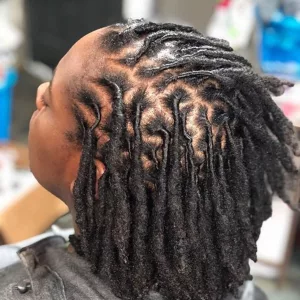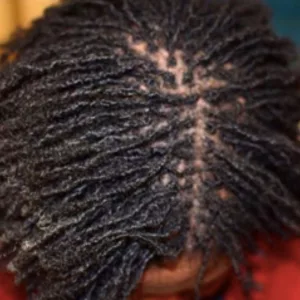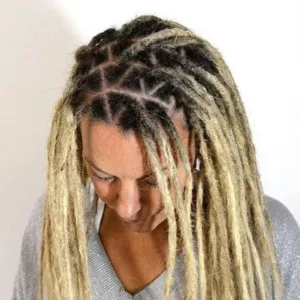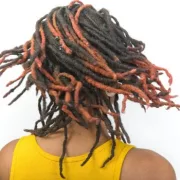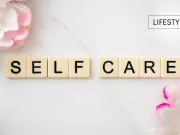
5 Different Methods to Starter Locs: Learn How to Start Dreads
Are you thinking about starting your dreadlock journey, but not sure where to begin? Look no further because we’ve got you covered with this comprehensive guide to starter locs!
Starting your dreadlocks can be a life-changing experience, but it’s essential to do it correctly from the beginning. Whether you’re new to the world of dreadlocks or an experienced wearer, this guide is packed with all the information you need to know about starter locs.
From what starter locs are and how to prepare for them, to the process of starting them and how to care for them once they’re started, we’ll cover everything you need to know. We’ll even provide tips and tricks for maintaining healthy starter locs.
Whether you’re looking for advice on how to prepare your hair for starter locs, the steps to follow when starting the process, or how to care for your locs once they’re fully formed, this guide has got you covered.
So, grab a cup of tea and get ready to learn everything you need to know about starter locs. And don’t forget to stick around for our hair care tips after coloring!
What Are Starter Locs?
Starter locs are simply the beginning stage of the dreadlock process. They are essentially baby dreads that are just starting to take shape. At this stage, the hair is parted into sections and twisted or coiled together to form small knots. Over time, these knots will continue to tighten and mature into fully-formed dreadlocks.
Preparing for Starter Locs
Before starting your dreadlock journey, it’s important to prepare your hair properly. Here are some tips on how to prepare your hair for starter locs:
- Wash your hair thoroughly. You want to make sure your hair is clean and free of any product buildup before starting your dreadlocks. Use a clarifying shampoo to remove any dirt, oil, or product buildup.
- Avoid using conditioner. Conditioner can soften the hair and make it difficult for the hair to knot up properly. Avoid using conditioner for at least a week before starting your dreadlocks.
- Avoid using heat. Heat can also soften the hair and make it difficult for the hair to knot up properly. Avoid using heat styling tools for at least a week before starting your dreadlocks.
- Trim your hair if necessary. If you have split ends or damaged hair, it’s a good idea to trim it before starting your dreadlocks. This will help your hair to knot up more easily.
Checkout our list: The 7 Best Hair Growth Shampoos of 2023 That Actually Work
How to Start Starter Locs: A Step-by-Step Guide
Now that you’ve prepared your hair for starter locs, it’s time to start the process. Here are the steps to follow:
- Step 1. Section your hair. Use a comb to part your hair into sections.
The size of the sections will depend on the thickness and length of your hair. Generally, the smaller the sections, the faster your hair will dread up.
- Step 2. Twist or coil each section.
Take each section of hair and twist or coil it tightly. Use a small amount of locking gel or wax if necessary to help the hair hold its shape.
- Step 3. Allow the hair to dry completely.
Once you’ve twisted or coiled all of your sections, allow your hair to dry completely. This may take several hours or overnight.
- Step 4. Palm roll the sections.
After your hair is completely dry, use your palms to roll each section back and forth. This will help to tighten the knots and encourage the hair to start dreading.
- Step 5. Repeat the process.
Repeat the twisting, drying, and palm rolling process every few days until your hair has fully locked up.
5 Best Methods to Start Locs
While there are several methods for starting locs, here are the 5 best methods in detail, along with advice for each method.
1) Two-strand twist method
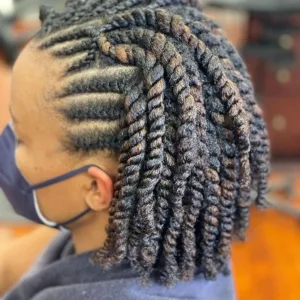
This method involves sectioning the hair and twisting each section with two strands of hair until it locks up. It is a popular method for starting locs as it is easy to do and requires minimal maintenance. However, it is important to avoid overtwisting the hair, which can cause breakage and thinning of the hair. To maintain the locs, twist the hair tightly and use a natural oil or conditioner to keep the hair moisturized and prevent tangling.
Advice: Twist the hair tightly, but not too tightly, to avoid damage and breakage.
2) Palm rolling method
This method involves rolling small sections of hair between your palms until they form tight coils. It is a great method for starting locs as it creates uniform, tight coils that are easy to maintain. However, excessive rolling can lead to weak locs. To maintain the locs, palm roll regularly to keep the locs tight and neat, and avoid using too much product that can weigh the hair down.
Advice: Avoid excessive rolling to prevent weak locs, and use natural products to avoid build-up.
3) Freeform method
This method involves allowing your hair to naturally lock up without any manipulation. It is a great method for those who want to embrace the natural beauty of their hair and have a more low-maintenance approach to starting locs. However, it takes longer for the locs to form, so be patient and keep the hair clean and moisturized to prevent tangling.
Advice: Be patient and gentle with this method, and keep the hair clean and moisturized to promote healthy growth.
4) Interlocking method
This method involves using a special tool to interlock the hair at the roots, creating tight knots. It is a popular method for starting locs as it creates strong and uniform locs. However, it is important to only interlock the hair once it has started to lock up on its own to avoid damaging the hair. To maintain the locs, be gentle with the tool and avoid excessive twisting.
Advice: Only interlock the hair once it has started to lock up naturally, and use the tool gently to avoid damage.
5) Braids/twist and rip method
This method involves braiding or twisting the hair and then ripping the braids/twists apart to create individual sections that will lock up over time. It is a great method for those who want to have a more organic and natural look to their locs. However, it is important to use a natural oil or conditioner to lubricate the hair before ripping apart the braids/twists and avoid over-ripping as it can cause uneven locs.
Advice: Use natural products to lubricate the hair before ripping, and avoid over-ripping to promote even locs.
Also Read: Top 10 Ways to Curl Your Hair Without Heat
Pros and Cons of Starter Locs: Is It Right for You?
Starter locs are an excellent way to express your individuality and embrace your natural hair texture. However, like any hairstyle, there are pros and cons to consider before taking the plunge. Here are some of the most important pros and cons of starter locs to help you decide if it’s the right choice for you:
Pros
- Low Maintenance: Once your starter locs have fully matured, they require very little maintenance, making them an ideal low-maintenance hairstyle.
- Versatile: Starter locs can be styled in a variety of ways, from updos and braids to loose waves and curls.
- Unique: No two sets of locs are the same, so you’re guaranteed a unique and individual look.
- Healthy Hair: Starter locs can be a great way to promote healthy hair growth by protecting your hair from daily manipulation and environmental damage.
Cons
- Time-Consuming: The process of starting and maturing your starter locs can take months to years, depending on your hair texture and length.
- Commitment: Starter locs require a significant commitment, as they cannot be undone without cutting off your hair.
- Patience: Maintaining your starter locs requires patience and dedication, as the process can be slow and require ongoing care.
- Professional Maintenance: Depending on the texture and thickness of your hair, it may be necessary to seek professional maintenance from a loctician, which can be expensive.
Ultimately, the decision to start your loc journey is a personal one, and it’s essential to consider both the pros and cons before taking the plunge. If you’re looking for a unique and low-maintenance hairstyle that promotes healthy hair growth, starter locs may be the right choice for you. However, if you’re not willing to commit to the process and ongoing maintenance, it may be best to consider other options.
How to Maintain Healthy Starter Locs: Top Tips & Tricks
Maintaining healthy starter locs is crucial for ensuring that your locs mature properly and stay strong and healthy. Here are some top tips and tricks for maintaining healthy starter locs:
Moisturize your scalp regularly. Dry scalp can lead to itching, flaking, and even hair loss. Use a natural oil, such as coconut oil or jojoba oil, to moisturize your scalp regularly and keep it healthy.
Use a lightweight best locking gel. Heavy products can cause buildup and prevent your hair from locking up properly. Use a lightweight locking gel specifically designed for dreadlocks to help maintain their shape and keep them looking healthy.
Avoid over-washing your hair. While it’s important to keep your hair clean, over-washing can strip your hair of its natural oils and cause dryness and breakage. Aim to wash your hair every 1-2 weeks, or as needed.
Be gentle with your hair when styling. Avoid pulling or twisting your hair too tightly, as this can cause breakage and damage. Use gentle styling techniques and avoid using heat styling tools.
Protect your hair from the elements. Exposure to the sun, wind, and other elements can cause damage to your hair. Wear a hat or scarf to protect your hair when you’re outside for extended periods of time.
By following these top tips and tricks for maintaining healthy starter locs, you’ll be well on your way to having strong, beautiful, and mature dreadlocks that you’ll love for years to come.
The Dos and Don’ts of Anti-Dandruff Hair Oils
Starter Locs vs Regular Locs: What’s the Difference?
When it comes to dreadlocks, there are two primary types: starter locs and regular locs. While they may look similar, there are some key differences between the two. Here’s what you need to know:
Starter Locs
Starter locs, also known as baby locs, are the beginning stages of the dreadlock process. At this stage, the hair is twisted or coiled together to form small knots that will mature into fully-formed locs over time.
Starter locs are typically shorter and thinner than mature locs, and they require more maintenance and care during the early stages of the locking process.
Regular Locs
Regular locs are fully matured dreadlocks that have completed the locking process. They are typically thicker and longer than starter locs, and they require less maintenance and care than starter locs.
Regular locs can be styled in a variety of ways, from updos and braids to loose waves and curls, and they are known for their unique and individual look.
Key Differences
This table compares Starter Locs to Regular Locs, outlining their differences in starting method, size, maintenance, appearance, development, styling, and cost. It can help you decide which approach is best for your loc journey.
| Aspect | Starter Locs | Regular Locs |
|---|---|---|
| Starting Method | Palm rolling or two-strand twists | Freeform or interlocking |
| Size | Generally smaller than regular locs | Vary in size and thickness |
| Maintenance | Require more frequent retightening | Require less frequent retightening |
| Appearance | Tend to have a neater, more uniform appearance | May have a more organic, uneven appearance |
| Development | May take longer to fully develop and mature | Can develop and mature more quickly |
| Styling | Limited styling options during early stages of growth | More styling options as locs mature and thicken |
| Cost | May be more expensive due to frequent maintenance needs | Generally less expensive due to lower maintenance needs |
FAQs About Starter Locs
Here are some frequently asked questions about starter locs:
It can take anywhere from 6 months to a year for starter locs to fully mature. The time it takes will depend on the texture and thickness of your hair, as well as how well you care for your locs.
Yes, you can and should wash your hair regularly with starter locs. Use a residue-free shampoo and be gentle when washing your hair.
Yes, you can start your own starter locs at home. However, it’s a good idea to seek the advice of a professional loctician to ensure you’re starting your locs properly.
You should retwist your starter locs every 4-6 weeks or as needed. Over-retwisting can cause breakage and damage, so be sure to only retwist when necessary.
Final words
Starting your dreadlock journey can be an exciting and rewarding experience. With proper preparation, the right technique, and good maintenance habits, your starter locs will transform into beautiful, mature dreadlocks. Remember to be patient, embrace the journey, and enjoy the process of watching your hair transform into something truly unique and beautiful.


